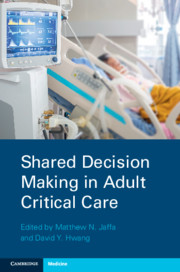Book contents
- Shared Decision Making in Adult Critical Care
- Shared Decision Making in Adult Critical Care
- Copyright page
- Dedication
- Contents
- Contributors
- Preface
- Chapter 1 When Does Shared Decision-Making Apply in Adult Critical Care?
- Chapter 2 How Much Does the Family Want to Be Involved in Decision-Making?
- Chapter 3 Show Me the Data
- Chapter 4 Communication Skills for Critical Care Family Meetings
- Chapter 5 The Do-Not-Resuscitate Order
- Chapter 6 The Do-Not-Intubate Order
- Chapter 7 Prolonged Ventilator Dependence for the Pulmonary Patient
- Chapter 8 Renal Replacement Therapy
- Chapter 9 Shared Decision-Making during Extracorporeal Membrane Oxygenation
- Chapter 10 Hypoxic–Ischemic Brain Injury after Cardiac Arrest
- Chapter 11 Decompressive Craniectomy for Stroke Patients
- Chapter 12 Decompressive Craniectomy for Traumatic Brain Injury Patients
- Chapter 13 Severe Traumatic Spinal Cord Injury
- Chapter 14 Potentially Inappropriate Treatment and Conscientious Objection
- Chapter 15 Shared Decision-Making in Emergent Situations
- Chapter 16 Advance Directives
- Chapter 17 Care of the Unbefriended Patient
- Chapter 18 The Role of Palliative Care in the Intensive Care Unit
- Chapter 19 Measuring and Evaluating Shared Decision-Making in the Intensive Care Unit
- Chapter 20 Brain Death Discussions
- Index
- References
Chapter 13 - Severe Traumatic Spinal Cord Injury
Published online by Cambridge University Press: 27 May 2021
- Shared Decision Making in Adult Critical Care
- Shared Decision Making in Adult Critical Care
- Copyright page
- Dedication
- Contents
- Contributors
- Preface
- Chapter 1 When Does Shared Decision-Making Apply in Adult Critical Care?
- Chapter 2 How Much Does the Family Want to Be Involved in Decision-Making?
- Chapter 3 Show Me the Data
- Chapter 4 Communication Skills for Critical Care Family Meetings
- Chapter 5 The Do-Not-Resuscitate Order
- Chapter 6 The Do-Not-Intubate Order
- Chapter 7 Prolonged Ventilator Dependence for the Pulmonary Patient
- Chapter 8 Renal Replacement Therapy
- Chapter 9 Shared Decision-Making during Extracorporeal Membrane Oxygenation
- Chapter 10 Hypoxic–Ischemic Brain Injury after Cardiac Arrest
- Chapter 11 Decompressive Craniectomy for Stroke Patients
- Chapter 12 Decompressive Craniectomy for Traumatic Brain Injury Patients
- Chapter 13 Severe Traumatic Spinal Cord Injury
- Chapter 14 Potentially Inappropriate Treatment and Conscientious Objection
- Chapter 15 Shared Decision-Making in Emergent Situations
- Chapter 16 Advance Directives
- Chapter 17 Care of the Unbefriended Patient
- Chapter 18 The Role of Palliative Care in the Intensive Care Unit
- Chapter 19 Measuring and Evaluating Shared Decision-Making in the Intensive Care Unit
- Chapter 20 Brain Death Discussions
- Index
- References
Summary
A 43-year-old woman was an unrestrained passenger in a high-speed motor vehicle collision. She was found by emergency medical services to be poorly responsive, with hypotension, mild bradycardia, and hypoventilation, and was intubated at the scene of the accident after a prolonged extrication. A chest tube had been placed based on radiographic findings upon hospital arrival. A computed tomography (CT) scan showed a cervical spine hyperflexion injury with a wedge fracture of the anterior vertebral body of C5 with posterior displacement of the posterior vertebral body and partial compromise of the spinal canal. CT imaging of the head was negative and abdominal and chest imaging showed multiple rib fractures and a subcapsular hematoma of the spleen. Sedation was discontinued shortly after arrival and she was found to have partial activation of the deltoids and elbow flexors, but was otherwise quadriplegic with no motor or sensory function below the C5 level, including absent voluntary anal contraction and perianal sensation. She was triggering the ventilator in a volume control mode. While preparations were made for urgent surgical decompression and stabilization with extensive laminectomy and posterior segmental fusion, magnetic resonance imaging was obtained, which demonstrated extensive cord signal change from C3 to C7 and posterior ligamentous injury, consistent with a flexion-teardrop fracture (Figure 13.1). You are now about to meet the patient’s husband to discuss the patient’s situation and to obtain consent for the surgery.
- Type
- Chapter
- Information
- Shared Decision Making in Adult Critical Care , pp. 115 - 124Publisher: Cambridge University PressPrint publication year: 2021



